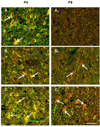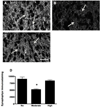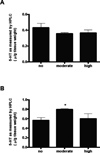Pb exposure prolongs the time period for postnatal transient uptake of 5-HT by murine LSO neurons
- PMID: 27771255
- PMCID: PMC5123977
- DOI: 10.1016/j.neuro.2016.10.010
Pb exposure prolongs the time period for postnatal transient uptake of 5-HT by murine LSO neurons
Abstract
Pb exposure is associated with cognitive deficits including Attention Deficit Hyperactivity Disorder (ADHD) in children and alters auditory temporal processing in humans and animals. Serotonin has been implicated in auditory temporal processing and previous studies from our laboratory have demonstrated that developmental Pb decreases expression of serotonin (5-HT) in the adult murine lateral superior olive (LSO). During development, certain non-serotonergic sensory neurons, including auditory LSO neurons, transiently take up 5-HT through the serotonin reuptake transporter (SERT). The uptake of 5-HT is important for development of sensory systems. This study examines the effect of Pb on the serotonergic system in the LSO of the early postnatal mouse. Mice were exposed to moderate Pb (0.01mM) or high Pb (0.1mM) throughout gestation and postnatal day 4 (P4) and P8. We found that Pb exposure prolongs the normal developmental expression of 5-HT by LSO neurons and this is correlated with expression of SERT on LSO cell bodies. The prolonged expression of 5-HT by postnatal LSO neurons is correlated with decreased synaptic immunolabeling within the LSO. This Pb-associated decrease in synaptic density within the LSO could contribute to the auditory temporal processing deficits and cognitive deficits associated with developmental Pb exposure.
Keywords: Auditory system; Development; Lead acetate; Serotonin; Serotonin reuptake transporter (SERT); Superior olivary nuclei.
Copyright © 2016 Elsevier B.V. All rights reserved.
Figures








References
-
- Alvarado JC, Fuentes-Santamaria V, Henkel CK, Brunso-Bechtold JK. Alterations in calretinin immunostaining in the ferret superior olivary complex after cochlear ablation. The Journal of comparative neurology. 2004;470:63–79. - PubMed
-
- Alvarez C, Vitalis T, Fon EA, Hanoun N, Hamon M, Seif I, Edwards R, Gaspar P, Cases O. Effects of genetic depletion of monoamines on somatosensory cortical development. Neuroscience. 2002;115:753–764. - PubMed
-
- Auso E, Cases O, Fouquet C, Camacho M, Garcia-Velasco JV, Gaspar P, Berbel P. Protracted expression of serotonin transporter and altered thalamocortical projections in the barrelfield of hypothyroid rats. Eur J Neurosci. 2001;14:1968–1980. - PubMed
-
- Bellinger DC. Very low lead exposures and children's neurodevelopment. Curr Opin Pediatr. 2008;20:172–177. - PubMed
MeSH terms
Substances
Grants and funding
LinkOut - more resources
Full Text Sources
Other Literature Sources

